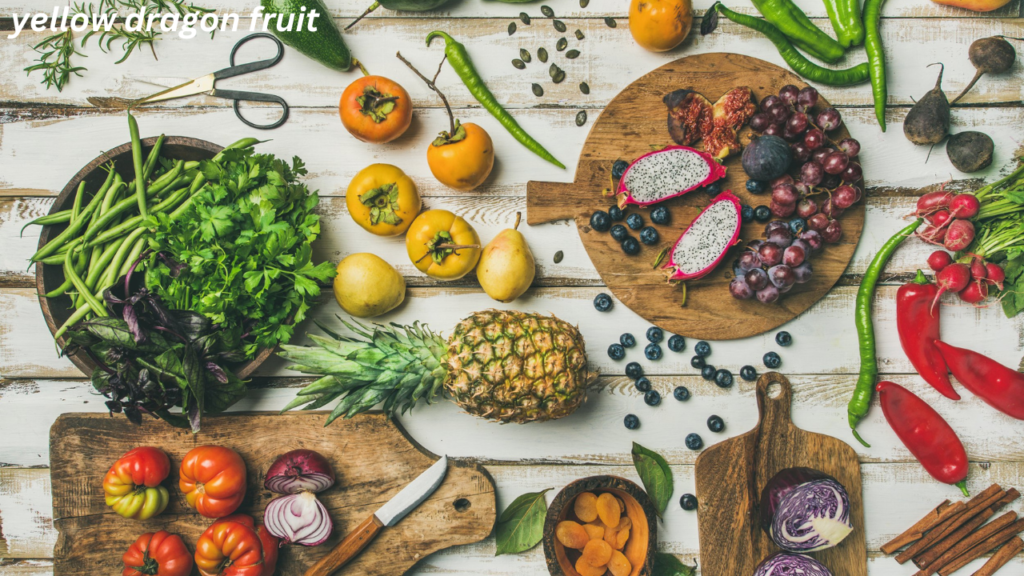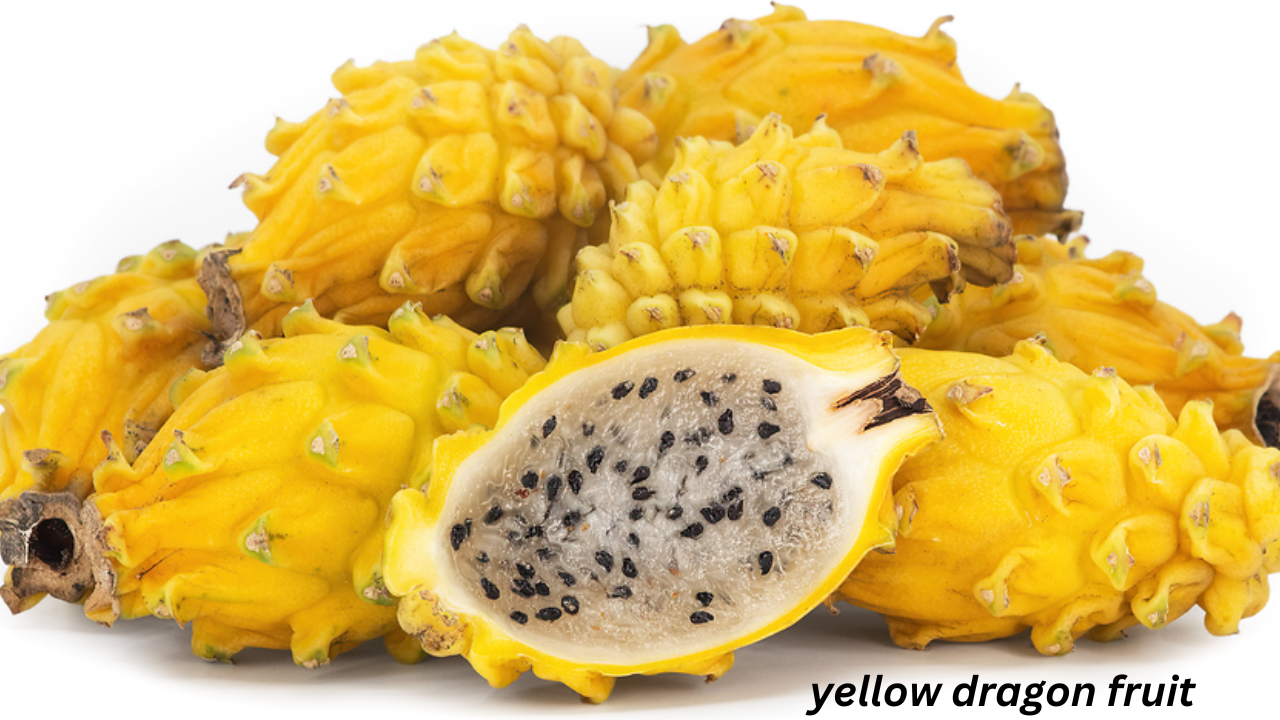Yellow dragon fruit, also known as Hylocereusyellow dragon fruit megalanthus, is one of the most visually captivating and nutritious fruits available today. With its vibrant yellow skin, white flesh, and specks of tiny black seeds, this exotic fruit is a tropical treat. In recent years, yellow dragon fruit has gained significant popularity worldwide, and many are discovering its health benefits, culinary versatility, and unique cultivation process. In this article, we’ll look in-depth at what makes yellow dragon fruit unique, its health benefits, how to grow it, and how to enjoy it in your daily meals.
What is Yellow Dragon Fruit?
Yellow dragon fruit is a type of cactus from the Hylocereus genus, including the more common red and white dragon fruit varieties. Its bright yellow skin and distinctive, mildly sweet flavor set the yellow dragon fruit apart. The flesh inside is white, with a crunchy texture due to the tiny black seeds scattered throughout, and the fruit itself is typically smaller than the red or white varieties, making it a more compact option for snacking.
Native to Central and South America, this fruit is also widely grown in tropical regions such as Vietnam, Thailand, and Israel. Although often confused with its red counterpart, yellow dragon fruit is a distinct variety with a unique taste and texture. Its natural sweetness makes it a great addition to various recipes, and it is often considered less acidic than its red cousin.
As a member of the cactus family, yellow dragon fruit thrives in arid environments but also grows in more temperate climates. The plant is a climbing cactus; its large, vibrant flowers bloom at night. These flowers give way to the small, oval-shaped fruit harvested once it reaches its full yellow hue.
Nutritional Value and Health Benefits

Yellow dragon fruit is not just a treat for the eyes; it’s also packed with essential nutrients and health benefits. This tropical fruit is low in calories and rich in vitamins and minerals, making it a fantastic addition to a healthy diet.
Rich in Vitamins and Minerals
One of the standout features of yellow dragon fruit is its high vitamin C content. Just one serving of this fruit provides nearly half of the daily recommended vitamin C intake, which helps boost the immune system and promote healthy skin. Along with vitamin C, yellow dragon fruit is also a good source of B vitamins like B1 (thiamine), B2 (riboflavin), and B3 (niacin), which help maintain overall health, support energy production, and promote healthy brain function.
Additionally, this fruit contains minerals such as iron and calcium. Iron helps produce red blood cells and ensures proper oxygen transport throughout the body, while calcium strengthens bones and teeth.
Antioxidants and Digestive Benefits
Yellow dragon fruit contains antioxidants, particularly betalains, which give it a distinctive color. Antioxidants help protect the body against oxidative stress and free radicals, which can lead to chronic diseases and premature aging. Antioxidants make yellow dragon fruit a powerful addition to any anti-aging or wellness regimen.
Another notable benefit of yellow dragon fruit is its high fiber content. Dietary fiber is crucial for digestive health as it aids bowel regularity, prevents constipation, and supports gut bacteria. It also promotes a feeling of fullness, making yellow dragon fruit an excellent snack for those looking to manage their weight. Additionally, fiber is beneficial for heart health, as it helps lower cholesterol levels.
Immune System Support
The vitamin C and antioxidants present in yellow dragon fruit work together to strengthen the immune system. Regularly consuming yellow dragon fruit can help the body ward off infections, colds, and other illnesses. This fruit’s anti-inflammatory properties also aid in reducing inflammation in the body, contributing to better overall health.
Cultivating Yellow Dragon Fruit
Growing yellow dragon fruit at home can be a rewarding and sustainable way to enjoy this exotic fruit. While it is typically cultivated in tropical regions, it’s possible to grow in various climates, provided the conditions are met.
Ideal Growing Conditions
Yellow dragon fruit plants thrive in warm, sunny environments and are best suited for regions with temperatures ranging from 65°F to 85°F (18°C to 30°C). They require plenty of direct sunlight, so it’s essential to plant them where they can receive several hours of sunlight each day. These plants are drought-tolerant but need regular watering, especially during hot periods, to maintain healthy growth.
The soil for yellow dragon fruit should be well-draining, as the plant is susceptible to root rot in waterlogged conditions. A slightly acidic to neutral pH level (5.5 to 7) is ideal for the plant. For those growing it in containers, using a cactus-specific potting mix is essential, allowing for proper drainage.
Planting and Care
Yellow dragon fruit can be propagated from both seeds and cuttings. Growing from seeds is a slower process, and it can take several years for the plant to mature and produce fruit. On the other hand, using cuttings from mature plants is a quicker method and allows for faster growth and fruiting. Cuttings should be placed in a well-draining potting mix and watered lightly until the roots are established.
Once the plant is established, it requires minimal care, though regular pruning is necessary to keep the plant manageable and encourage healthy growth. A trellis or support structure is recommended to support the climbing cactus as it grows. Fertilizing the plant with a balanced fertilizer every few months can also help promote better growth and fruit production.
Common Pests and Diseases
While yellow dragon fruit is relatively low-maintenance, it can still prey on pests such as mealybugs, scale insects, and aphids. Regular inspection and organic pest control methods can help keep these pests at bay. Dragon fruit is also susceptible to fungal diseases, particularly in overly humid or wet environments. Ensuring good airflow and proper watering practices can help prevent fungal growth.
How to Enjoy Yellow Dragon Fruit
Yellow dragon fruit is as versatile in the kitchen as in the garden. Its mild sweetness and refreshing taste make it an excellent addition to various dishes.
Culinary Uses
Eating it fresh is one of the most popular ways to enjoy yellow dragon fruit. Cut the fruit in half and scoop the flesh with a spoon. You can enjoy it as is or add it to fruit salads, yogurt, or smoothies for extra flavor and nutrition. Its unique texture makes it a great addition to fruit bowls, where it pairs well with other tropical fruits like mango, pineapple, and papaya.
Those with a sweet tooth can use yellow dragon fruit in desserts such as ice cream, sorbets, or puddings. It can also be blended into refreshing beverages, creating a healthy alternative to sugary drinks.
Storing Yellow Dragon Fruit
If you’ve bought more dragon fruit than you can consume in one sitting, don’t worry. Yellow dragon fruit can be stored in the refrigerator for up to 5 days, allowing you to enjoy it at your leisure. You can also freeze the fruit for later use—cut it into chunks, place it in an airtight container, and store it in the freezer. This makes it easy to incorporate yellow dragon fruit into smoothies or desserts at any time.
Conclusion
Yellow dragon fruit is a delicious and nutrient-packed fruit with many health benefits. Yellow dragon fruit is an excellent choice to improve your immune system, support your digestive health, or add a unique fruit to your diet. Its growing popularity worldwide is a testament to its versatility and appeal in terms of nutrition and culinary uses. By increasing your yellow dragon fruit, you can enjoy this exotic fruit fresh from your garden or add it to your diet in countless ways.
FAQs
What is the difference between yellow and red dragon fruit?
Yellow dragon fruit has a bright yellow skin and a sweeter, milder flavor, while red dragon fruit has a red skin and typically a more robust taste. The flesh of yellow dragon fruit is white, while red dragon fruit can have either white or red flesh.
Is yellow dragon fruit high in sugar?
Yellow dragon fruit is relatively low in sugar compared to other tropical fruits. It contains natural sugars, but its calorie content remains low, making it a healthy option for those monitoring their sugar intake.
How can I grow yellow dragon fruit at home?
Yellow dragon fruit can be grown in warm, sunny environments with well-draining soil. You can propagate it from seeds or cuttings; once established, the plant requires minimal care.
Can yellow dragon fruit be eaten raw?
Yes, yellow dragon fruit is typically eaten raw. Cut it in half and scoop out the flesh with a spoon.
Is yellow dragon fruit good for weight loss?
Yes, yellow dragon fruit is high in fiber, which helps keep you full longer and supports healthy digestion, making it an excellent snack for weight management.
You May Also Read: https://ventsworlds.com/merriam-webster-quordle/

